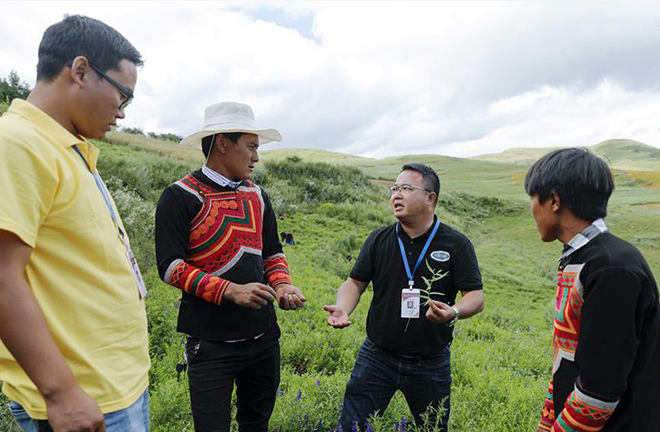Poverty alleviation in Liangshan makes great achievements

Xia Jiyi (2nd from right), an associate professor from Southwest Medical University, teaches the Yi people the techniques of planting and picking Chinese skullcap near Zhaojue County, Liangshan Yi Autonomous Prefecture. Photo: Shen Bohan/XINHUA
Daliang Mountain and Xiaoliang Mountain in Sichuan Province are a concentrated and contiguous area of extreme poverty. Currently, Liangshan, which has been poor and behind for thousands of years, is undergoing historic changes.
In recent years, poverty alleviation work in Liangshan Yi Autonomous Prefecture has focused on building the confidence and capacity to pull rural residents out of poverty, assisting people’s livelihoods and local industries as well as education, making great achievements.
Erji Village is located northeast of Xide County, Liangshan, over 2,400 meters above the sea level and 12 kilometers from the county center. The Sichuan Academy of Social Sciences has built a farm to hold 5,000 pigs, 600 acres of Chinese red pepper and 30 acres of rhizoma atractylodis to increase income. Supported by the assistance of the Sichuan Academy, there have been many sheep and bee farmers who have yielded good returns.
Meanwhile, the academy has put efforts into educational poverty alleviation. Li Houqiang, Party secretary of the Sichuan Academy of Social Sciences, said that the academy has established an association to promote education, set up scholarships for freshmen and subsidies for excellent high school students from poor families, which is a solid foundation for stopping poverty from passing on to the next generation.
At present, all the villages in Liangshan have been experiencing the same historical changes. Ganluo County in Liangshan is an extreme impoverished county. Sichuan University (SCU), as the assigned partner of the county, has taken up the responsibility of supporting Ganluo. SCU has fully utilized its advantages as a comprehensive university, innovated with poverty assistance measures and explored the “Sichuan University Model” for targeted poverty alleviation. On Feb. 14, Ganluo County was officially withdrawn from the list of poverty-stricken counties, achieving its poverty alleviation. As an example from just one aspect of poverty relief, SCU has used the medical resources of West China Hospital, which is a national medical center to cure emergent and severe diseases in Western China, undertaking the role of supporting county hospitals in border areas.
Wang Zhuo, director of the Western China Poverty Reduction Research Center at SCU, has investigated Liangshan several times. She said that parents in Liangshan have paid more and more attention to children’s education, which left a great impression on her. The government has made great efforts to construct kindergartens and primary schools just for the purpose of keeping children’s minds on studying.
Since June 2018, the government of Sichuan Province organized a help team consisting of over 5,700 cadres and assigned them to work in 11 extremely impoverished counties in Liangshan for three years to help local residents rid themselves of poverty. One of the members of the help team, Wang Suzhen, a young scholar with the Law Institute under the Sichuan Academy of Social Sciences, studied the Yi language, came to understand the ideas and living habits of the villagers, and established a mutual aid association serving women’s health and education in the village. She held lectures twice a week to explain women’s rights and obligations and organized a reading club for children every weekend. Meanwhile, she conducted health appraisal activities in the village, trying to gradually change the backward concepts and habits of the villagers.
China West Normal University (CWNU) sent 51 students to gain practice as interns teaching children in Liangshan. Wang Anping, Party secretary of CWNU, hopes that these students will contribute their abilities to the places most in need in our country.
Daliang Mountain is now experiencing dramatic improvement, while the effective connection between targeted poverty assistance and rural revitalization has drawn widespread concern.
Puchi Daling, a professor of the Institute of Ethnology and Anthropology under the Chinese Academy of Social Sciences (CASS), said that Liangshan possesses well-preserved travel resources with ethnic characteristics and ecological resources. It is necessary to highlight its resource advantages and dig out a road which could lead local people to permanently ridding themselves of poverty guided by the direction of targeted poverty alleviation and tourism development.
He suggested that we should rely on rural tourism and allow administrative villages to fully excavate ecological resources, ethnic customs and rural pastoral resources. We should also adhere to the concept of “combining villages and tourism and using tourism to enrich villages” while promoting the “One Village, One Product” characteristic tourism model. In addition, we need to gradually improve basic rural tourism conditions, create rural tourism brands featuring various ethnic cultures and then create a rural tourism path that relies on the advantages of natural ecological resources in the Yi area and prominent ethnic culture.
Tan Xuewen, a research fellow in the Rural Development Institute under CASS, pointed out two tasks when he referred to the work in the next phase. The first is to consolidate the achievements of poverty alleviation and the second is to address the relative poverty. Multiple standard systems of relative poverty could be constructed in the period of the 14th five-year plan. Moreover, we should shift our concentration from the development-oriented poverty relief system to the coordinated development of the social welfare systems for urban and rural residents and integrate the development-oriented poverty relief policies with rural revitalization and supportive policies about developing poor regions.
Li said that in the next phase, we need to explore a long-term effective system to help rural residents shake off poverty and obtain more wealth. Currently, the Sichuan Academy of Social Sciences is doing research on the practice of poverty governance with Chinese characteristics in Liangshan and investigating Liangshan with the Liangshan government. They are preparing to summarize Liangshan’s poverty alleviation experience and take China’s experience with and plans for alleviating rural poverty and share them with the world.
edited by NIU XIAOQIAN
